Paper on Pilot Study Design
21 Pages5608 Words44 Views
Added on 2020-05-04
Paper on Pilot Study Design
Added on 2020-05-04
ShareRelated Documents
Running head: PILOT STUDY DESIGN 1
A DESIGN OF A PILOT STUDY TO INVESTIGATE WHETHER INCREASE IN
SHIFT LENGTH (FROM 7.5 HR TO 12 HR SHIFTS) INCREASES THE RATE OF
SICKNESS ABSENCES AMONG NURSING STAFF
Name
Institution
A DESIGN OF A PILOT STUDY TO INVESTIGATE WHETHER INCREASE IN
SHIFT LENGTH (FROM 7.5 HR TO 12 HR SHIFTS) INCREASES THE RATE OF
SICKNESS ABSENCES AMONG NURSING STAFF
Name
Institution
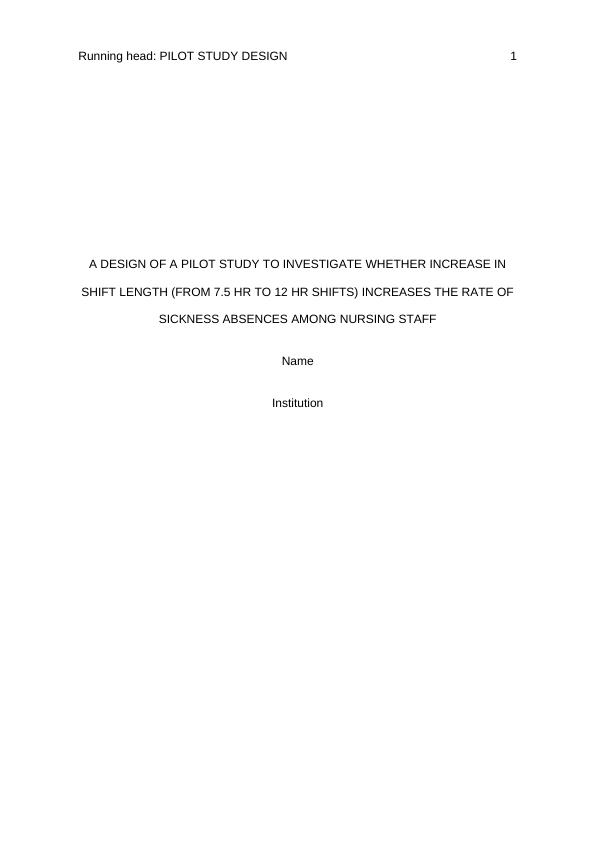
PILOT STUDY DESIGN 2
Contents
Contents......................................................................................................................................2
Introduction................................................................................................................................3
Main body..................................................................................................................................4
Literature Search....................................................................................................................4
Evaluating evidence based on hierarchy of evidence........................................................6
Pilot Study Design..................................................................................................................7
Research question...............................................................................................................7
Research approach.............................................................................................................7
Study design.......................................................................................................................8
Sampling............................................................................................................................9
Data collection...................................................................................................................9
Data analysis....................................................................................................................10
Recruitment process.........................................................................................................11
Ethical consideration (consent/approval).........................................................................12
Dissemination and Implementation......................................................................................14
Conclusion............................................................................................................................16
Contents
Contents......................................................................................................................................2
Introduction................................................................................................................................3
Main body..................................................................................................................................4
Literature Search....................................................................................................................4
Evaluating evidence based on hierarchy of evidence........................................................6
Pilot Study Design..................................................................................................................7
Research question...............................................................................................................7
Research approach.............................................................................................................7
Study design.......................................................................................................................8
Sampling............................................................................................................................9
Data collection...................................................................................................................9
Data analysis....................................................................................................................10
Recruitment process.........................................................................................................11
Ethical consideration (consent/approval).........................................................................12
Dissemination and Implementation......................................................................................14
Conclusion............................................................................................................................16
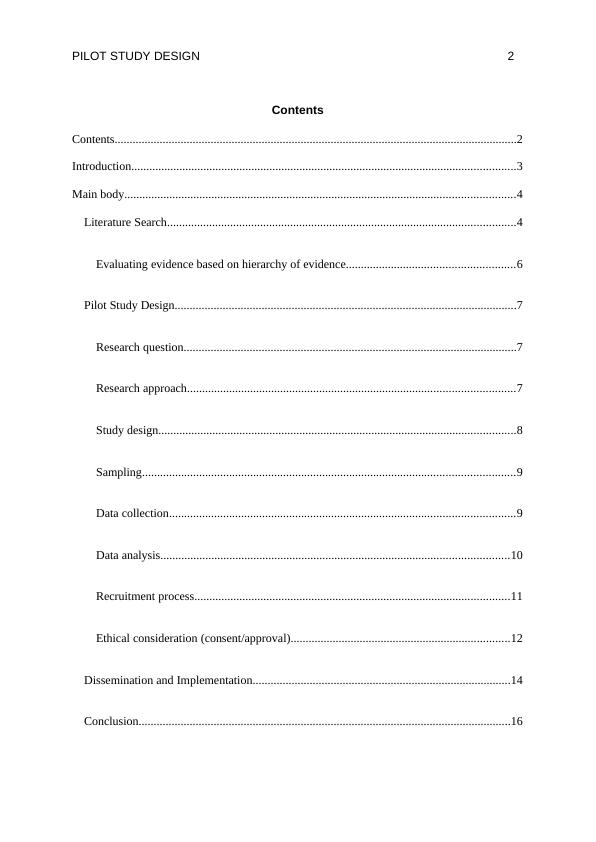
PILOT STUDY DESIGN 3
Introduction
Long work shifts of 15 hours or more for hospital staff nurses are common and also
popular in most hospitals in Singapore and abroad. However, little is known about
the effect of working longer hours on the level of care the nurses provide to their
patient or let alone on the nurses' health. A limited amount of research has been
done on the impact of long shifts on nurses (Trinkoff, Le, Geiger-Brown, & Lipscomb,
2007), or on the quality of care that they do provide (Stone, et al., 2007; Trinkoff, et
al., 2007). Further, it is not adequately understood whether long shifts increase the
rate of sickness absence among nursing staff. There is thus the need of investigating
the relationship between hospital nurses’ shift length and the frequency of their
sickness absences.
This paper discusses how a pilot study can be designed and undertaken for the
purposes of achieving this goal. There are three main sections. The first section is a
discussion on the search for evidence, including the sources of relevant literature
and evaluation of this evidence. The design of the study is discussed in the second
section. This includes the research question and research approach to be adopted,
and also the data collection and analysis procedures. The last section is a discussion
on the dissemination of the work and implementation for change in practice.
Introduction
Long work shifts of 15 hours or more for hospital staff nurses are common and also
popular in most hospitals in Singapore and abroad. However, little is known about
the effect of working longer hours on the level of care the nurses provide to their
patient or let alone on the nurses' health. A limited amount of research has been
done on the impact of long shifts on nurses (Trinkoff, Le, Geiger-Brown, & Lipscomb,
2007), or on the quality of care that they do provide (Stone, et al., 2007; Trinkoff, et
al., 2007). Further, it is not adequately understood whether long shifts increase the
rate of sickness absence among nursing staff. There is thus the need of investigating
the relationship between hospital nurses’ shift length and the frequency of their
sickness absences.
This paper discusses how a pilot study can be designed and undertaken for the
purposes of achieving this goal. There are three main sections. The first section is a
discussion on the search for evidence, including the sources of relevant literature
and evaluation of this evidence. The design of the study is discussed in the second
section. This includes the research question and research approach to be adopted,
and also the data collection and analysis procedures. The last section is a discussion
on the dissemination of the work and implementation for change in practice.
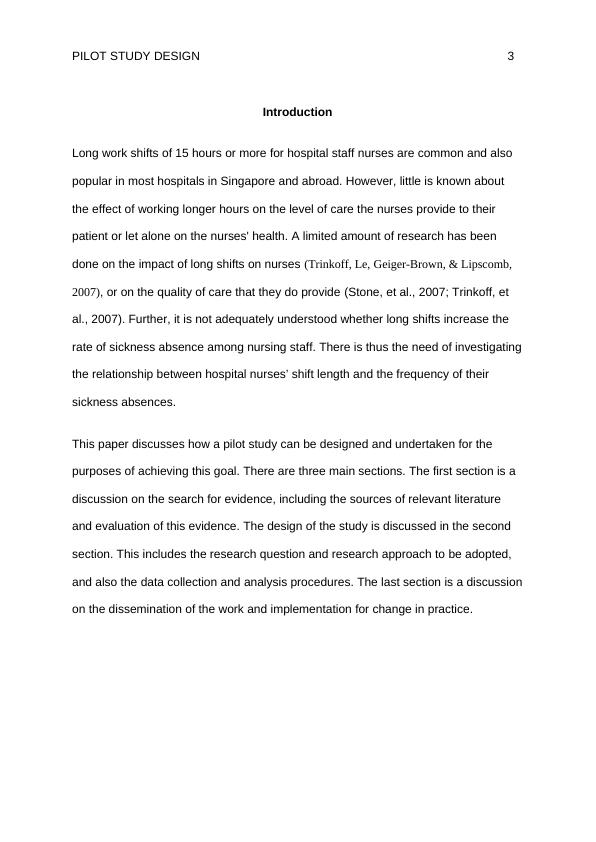
PILOT STUDY DESIGN 4
Main body
Literature Search
Evidence relevant to the chosen scenario will be obtained through a systematic
literature search. This may include grey literature sources, encyclopaedias and
relevant databases. Grey sources include literature that is yet to be formally
published in books or journal articles. Some of the grey sources relevant to this study
may include theses, MOH reports, conference proceedings and other official
documents. The use of grey literature may be debated in some cases owing to the
fact that it is not peer-reviewed nor evaluated. However, in the recent past, many
authors have come to emphasize the importance of grey literature as a tool that fills
the void brought about by the delay between research and publication, and the
failure to publish some research, which all prevent the access to useful information
(Pappa & William, 2011). This is justification enough to include grey literature sources
in the search for literature for this study in light of the fact that minimal research has
been undertaken on this topic. With regard to database search, some of the
databases applicable in this study include CINAHL Journal Databases,
ScienceDirect, MEDLINE, Singapore Ministry of Health (MOH), Singapore Nursing
journal, PubMed Central and the Cochrane Database of Systematic Reviews. The
search for literature can then be carried using keywords derived from the question
under study. The terms ‘Shift Length’, ‘8 hour or 12 hour shift’, long shifts, and
‘sickness Absence’ can be used for the search of the databases. The only filter
applicable to the search is that the sources ought to be within the last 5-10 years. A
Main body
Literature Search
Evidence relevant to the chosen scenario will be obtained through a systematic
literature search. This may include grey literature sources, encyclopaedias and
relevant databases. Grey sources include literature that is yet to be formally
published in books or journal articles. Some of the grey sources relevant to this study
may include theses, MOH reports, conference proceedings and other official
documents. The use of grey literature may be debated in some cases owing to the
fact that it is not peer-reviewed nor evaluated. However, in the recent past, many
authors have come to emphasize the importance of grey literature as a tool that fills
the void brought about by the delay between research and publication, and the
failure to publish some research, which all prevent the access to useful information
(Pappa & William, 2011). This is justification enough to include grey literature sources
in the search for literature for this study in light of the fact that minimal research has
been undertaken on this topic. With regard to database search, some of the
databases applicable in this study include CINAHL Journal Databases,
ScienceDirect, MEDLINE, Singapore Ministry of Health (MOH), Singapore Nursing
journal, PubMed Central and the Cochrane Database of Systematic Reviews. The
search for literature can then be carried using keywords derived from the question
under study. The terms ‘Shift Length’, ‘8 hour or 12 hour shift’, long shifts, and
‘sickness Absence’ can be used for the search of the databases. The only filter
applicable to the search is that the sources ought to be within the last 5-10 years. A
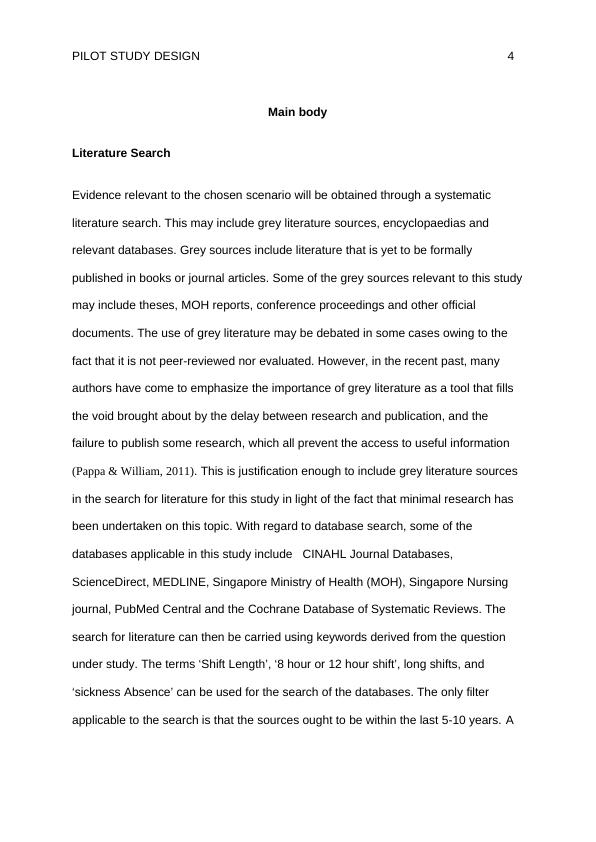
PILOT STUDY DESIGN 5
check on the reference lists of the retrieved publications can also be done to uncover
any relevant studies that can be adopted.
a) Shift length (or)
AND
b) Nurse*Nurses*(or)
AND
c) Sickness absence
(or)
8 hour or 12 hour shift (or)
Long shifts (or)
Nursing (or) Sick leave (or)
Sickness absenteeism
(or)
Table 1: Search Terms
A search on PubMed Central using the above terms returns a total of 12,700 results.
To be included in the review, the studies have to meet the following criteria (1)
compares between 8-hour shifts and 12-hour shifts with regard to frequency of
sickness absence among nurses (2) the sample and setting are nurses and the
hospital setting, and (3) written in English. Based on this criterion, only two results
(Ball, et al., 2017; Castro, et al., 2010) are relevant to the current study. A search on
CINAHL yields returns two relevant results (after screening for duplicates). One of
them is a report on a study on sickness absence and shifts among nurses and
healthcare assistants in acute care general hospitals across Europe (Griffiths, et al.,
2014), while the other is a systematic review of literature on the effect of 12-hour
shifts among ICU nurses (Aveyard, 2016). The Medline database search yields two
additional results (Martin, 2015; Samra & Smith, 2015) that can be included in this
review. An overview of the reference lists from the above-identified sources returned
two additional results (Rajbhandary & Basu, 2010; Ball, et al., 2015) that are eligible for
inclusion. Notably, a search on both the Cochrane Database of Systematic Reviews,
the MOH website, Singapore Journal of Nursing and ScienceDirect returns nil
additional results.
check on the reference lists of the retrieved publications can also be done to uncover
any relevant studies that can be adopted.
a) Shift length (or)
AND
b) Nurse*Nurses*(or)
AND
c) Sickness absence
(or)
8 hour or 12 hour shift (or)
Long shifts (or)
Nursing (or) Sick leave (or)
Sickness absenteeism
(or)
Table 1: Search Terms
A search on PubMed Central using the above terms returns a total of 12,700 results.
To be included in the review, the studies have to meet the following criteria (1)
compares between 8-hour shifts and 12-hour shifts with regard to frequency of
sickness absence among nurses (2) the sample and setting are nurses and the
hospital setting, and (3) written in English. Based on this criterion, only two results
(Ball, et al., 2017; Castro, et al., 2010) are relevant to the current study. A search on
CINAHL yields returns two relevant results (after screening for duplicates). One of
them is a report on a study on sickness absence and shifts among nurses and
healthcare assistants in acute care general hospitals across Europe (Griffiths, et al.,
2014), while the other is a systematic review of literature on the effect of 12-hour
shifts among ICU nurses (Aveyard, 2016). The Medline database search yields two
additional results (Martin, 2015; Samra & Smith, 2015) that can be included in this
review. An overview of the reference lists from the above-identified sources returned
two additional results (Rajbhandary & Basu, 2010; Ball, et al., 2015) that are eligible for
inclusion. Notably, a search on both the Cochrane Database of Systematic Reviews,
the MOH website, Singapore Journal of Nursing and ScienceDirect returns nil
additional results.
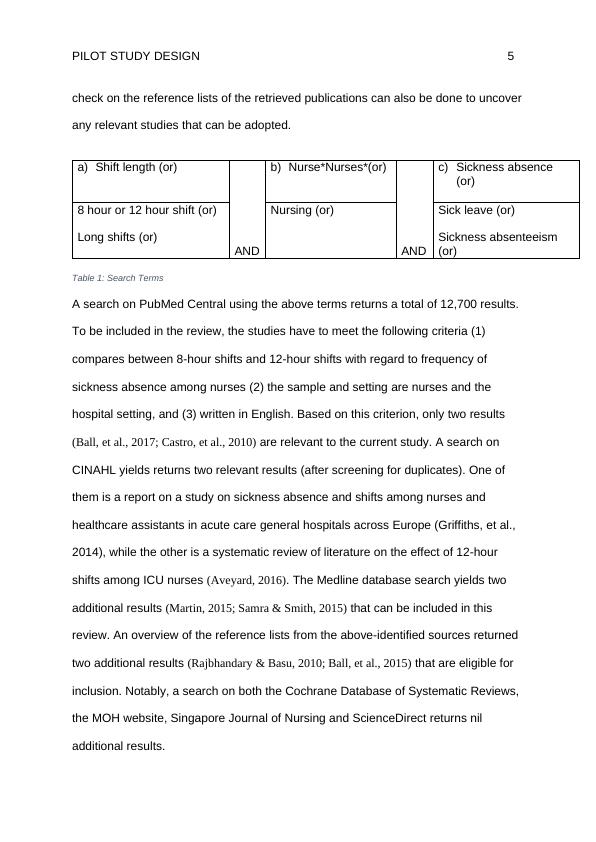
PILOT STUDY DESIGN 6
Evaluating evidence based on hierarchy of evidence
The evidence for the current study can be evaluated using nursing research
hierarchy of evidence (Del Mar, Hoffmann, & Glasziou, 2013). According to this
hierarchy, the most reliable forms of research are located at the apex (level 1) of the
pyramid, while the base (level 7) contains the least reliable ones. As explained by
Ingham-Broomfield (2016), at level 1 is systematic reviews and meta-analyses,
followed by critically appraised topics in level 2, while in level 3 are critically-
appraised individual articles. Level 4 and 5 are random control trials and cohort
studies respectively. Case-controlled studies, case reports, case series and cross-
sectional surveys are ranked in level 6. Lastly in level 7 are ideas, expert opinions,
editorials and anecdotal experiences.
The sources of the literature identified earlier on including two systematic reviews,
four surveys, one experimental study, and one expert statement. Thus, a majority
are classified into levels 1 and 6. Those in level 1 provide high-level evidence and
thus can form the basis for the larger literature review. While the primary studies
conducted in studies under level 6 are suitable alternatives when systematic reviews
are not adequate (Hoffman, Bennett, & Del Mar, 2013).
Evaluating evidence based on hierarchy of evidence
The evidence for the current study can be evaluated using nursing research
hierarchy of evidence (Del Mar, Hoffmann, & Glasziou, 2013). According to this
hierarchy, the most reliable forms of research are located at the apex (level 1) of the
pyramid, while the base (level 7) contains the least reliable ones. As explained by
Ingham-Broomfield (2016), at level 1 is systematic reviews and meta-analyses,
followed by critically appraised topics in level 2, while in level 3 are critically-
appraised individual articles. Level 4 and 5 are random control trials and cohort
studies respectively. Case-controlled studies, case reports, case series and cross-
sectional surveys are ranked in level 6. Lastly in level 7 are ideas, expert opinions,
editorials and anecdotal experiences.
The sources of the literature identified earlier on including two systematic reviews,
four surveys, one experimental study, and one expert statement. Thus, a majority
are classified into levels 1 and 6. Those in level 1 provide high-level evidence and
thus can form the basis for the larger literature review. While the primary studies
conducted in studies under level 6 are suitable alternatives when systematic reviews
are not adequate (Hoffman, Bennett, & Del Mar, 2013).
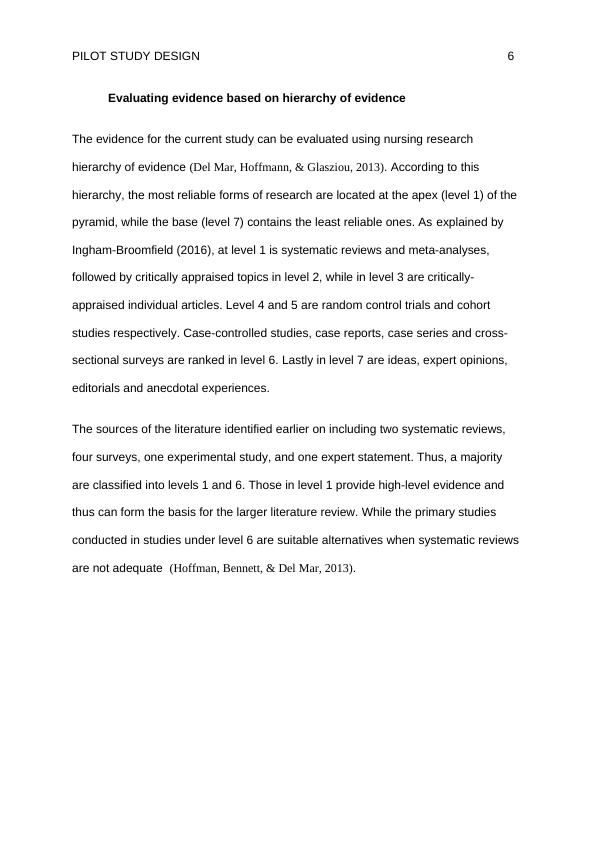
End of preview
Want to access all the pages? Upload your documents or become a member.
Related Documents
Research Pilot Design for Nursing Research Name of the Student University Namelg...
|24
|5972
|495
Nursing : In-equality in Healthcarelg...
|17
|3553
|15
Systematic Study Review.lg...
|12
|3031
|144
Does Repositioning Effect Rates of Pressure Injuries in Elderly People?lg...
|1
|1121
|53
Effectiveness of Mirror Therapy in Stroke Treatmentlg...
|11
|2038
|1
Case Study about Healthcare 2022lg...
|12
|3217
|19
